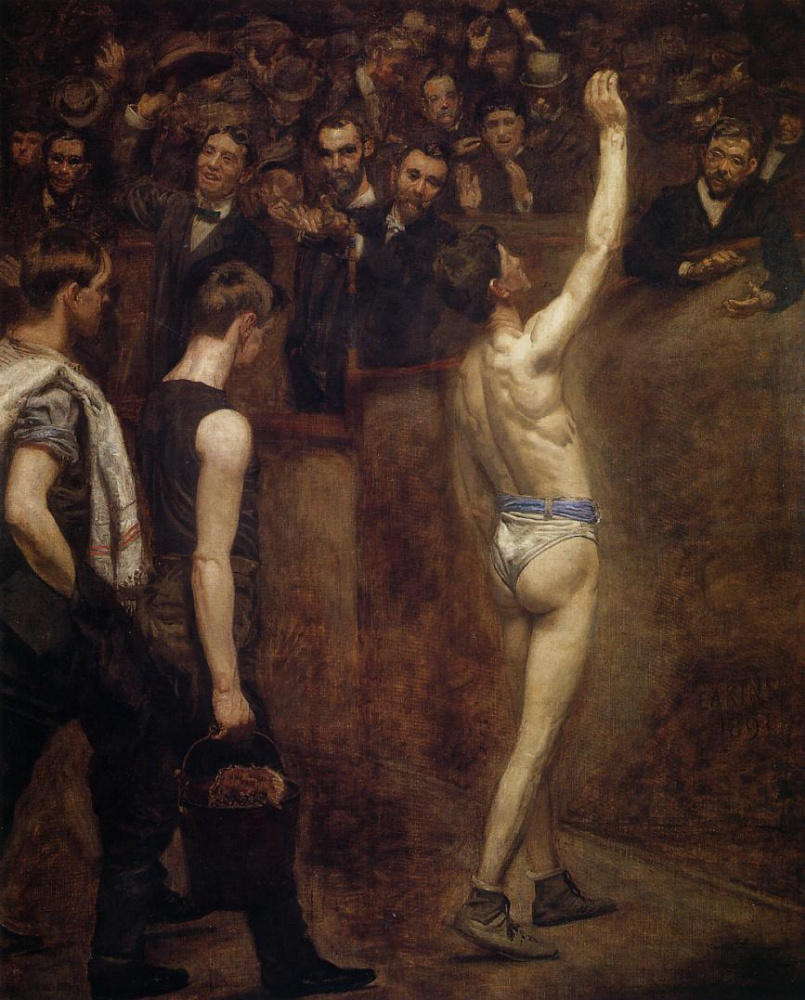log in
Enter site
Login to use Arthive functionality to the maximum
Greeting
Thomas Eakins • Painting, 1898, 127×101.6 cm
Description of the artwork «Greeting»
If at the beginning of his art career frequent protagonists of the paintings of Thomas Eakins was the rowers (1, 2), in the late 1890s, he turns to a new theme, reflecting his passion for the sport. In the artist's canvases again begin to appear half-naked men (which caused another wave of rumors about the sexual orientation Eakins) – at this time, the wrestlers and boxers. The artist began to attend Boxing matches and with friends sports commentators invited fighters to his Studio, where they posed for him. One of them was a boxer in the Featherweight Billy Smiththe hero of the two Eakins paintings – "Greetings" (Salutat) and "Between rounds".
Both of these paintings depict scenes from real Boxing match held on 22 April 1898, which was attended by the artist. Billy Smith fought with another fighter in the Featherweight – Tim Callaghan – and lost. However, Eakins sinned against the truth in the "Greeting" portrayed Smith as the winner, greeting the audience with a wave of the right hand, as did the gladiators. On the original frame paintings the artist engraved the inscription in Latin: "Dextra victrice conclamantes salvtat" (rough translation: "He triumphantly welcomed screaming right hand").
Eakins clearly highlights the figure of Billy, clearly drawing the topography of his muscles, causing the boxer seem to be brought to the forefront, but compositionally closer to the viewer are his seconds. Remaining in the shadows of the audience in the stands reminds students of earlier paintings by the artist – "The Gross Clinic"and "Clinic of Dr. Agnew". By the way, the prototypes for some of the audience was friends and acquaintances Eakins, who visited him in the Studio while working on a painting. In particular, the artist captures on the canvas of his friend Louis Kenton, sportswriter Clarence Cranmer, his student and protégé Samuel Murray, and even father Benjamin Eakins.
Author: Eugene Sidelnikov
Both of these paintings depict scenes from real Boxing match held on 22 April 1898, which was attended by the artist. Billy Smith fought with another fighter in the Featherweight – Tim Callaghan – and lost. However, Eakins sinned against the truth in the "Greeting" portrayed Smith as the winner, greeting the audience with a wave of the right hand, as did the gladiators. On the original frame paintings the artist engraved the inscription in Latin: "Dextra victrice conclamantes salvtat" (rough translation: "He triumphantly welcomed screaming right hand").
Eakins clearly highlights the figure of Billy, clearly drawing the topography of his muscles, causing the boxer seem to be brought to the forefront, but compositionally closer to the viewer are his seconds. Remaining in the shadows of the audience in the stands reminds students of earlier paintings by the artist – "The Gross Clinic"and "Clinic of Dr. Agnew". By the way, the prototypes for some of the audience was friends and acquaintances Eakins, who visited him in the Studio while working on a painting. In particular, the artist captures on the canvas of his friend Louis Kenton, sportswriter Clarence Cranmer, his student and protégé Samuel Murray, and even father Benjamin Eakins.
Author: Eugene Sidelnikov


